Can Basil Survive 40 Degrees
Basil plants can tolerate temperatures up to 35°C (95°F), but they may start to suffer if temperatures rise above 40°C (104°F). In hot weather, basil plants need to be watered more frequently and may need to be shaded from the sun during the hottest part of the day. Mulching around the plants can also help to keep the soil cool and moist.
Basil Temperature Range
Basil plants thrive within a specific temperature range. They prefer warm temperatures between 65°F (18°C) and 85°F (29°C). However, basil plants can tolerate temperatures as low as 50°F (10°C) or as high as 95°F (35°C) for short periods.
When temperatures exceed 95°F (35°C), basil plants may experience heat stress. Symptoms of heat stress include wilting, yellowing leaves, and stunted growth. Prolonged exposure to temperatures above 100°F (38°C) can be fatal to basil plants.
On the other hand, basil plants can also be damaged by cold temperatures. Temperatures below 50°F (10°C) can cause basil leaves to turn black and fall off. Basil plants exposed to temperatures below 40°F (4°C) may die.
Therefore, it is important to protect basil plants from extreme temperatures. If temperatures are expected to drop below 50°F (10°C), basil plants should be brought indoors or covered with a frost blanket. If temperatures are expected to rise above 95°F (35°C), basil plants should be watered deeply and mulched to help keep their roots cool.

Growing Basil in Hot Climates
Basil is a warm-season herb that thrives in hot climates. However, it is important to provide basil with the right conditions to ensure optimal growth and prevent heat stress. Here are some tips for growing basil in hot climates:
- Choose a heat-tolerant variety. Several varieties of basil are more tolerant of heat than others. Some good choices include ‘Genovese’, ‘Sweet Basil’, and ‘Thai Basil‘.
- Plant basil in a sunny location. Basil needs at least 6 hours of sunlight per day to grow well. However, in hot climates, it is best to plant basil in a location that receives morning sun and afternoon shade.
- Water basil regularly. Basil needs to be watered regularly, especially during hot weather. Water the basil deeply and allow the soil to dry out slightly before watering again.
- Fertilize basil regularly. Basil benefits from regular fertilization. Fertilize basil every few weeks with a balanced fertilizer.
- Mulch basil. Mulching basil helps to retain moisture and keep the soil cool. Use a layer of organic mulch, such as compost or straw, around your basil plants.
- Prune basil regularly. Pruning basil encourages new growth and helps to prevent the plant from becoming leggy. Pinch back the tips of the basil stems regularly.
- Harvest basil regularly. Harvesting basil regularly helps to promote new growth and keep the plant healthy. Harvest basil leaves as needed.
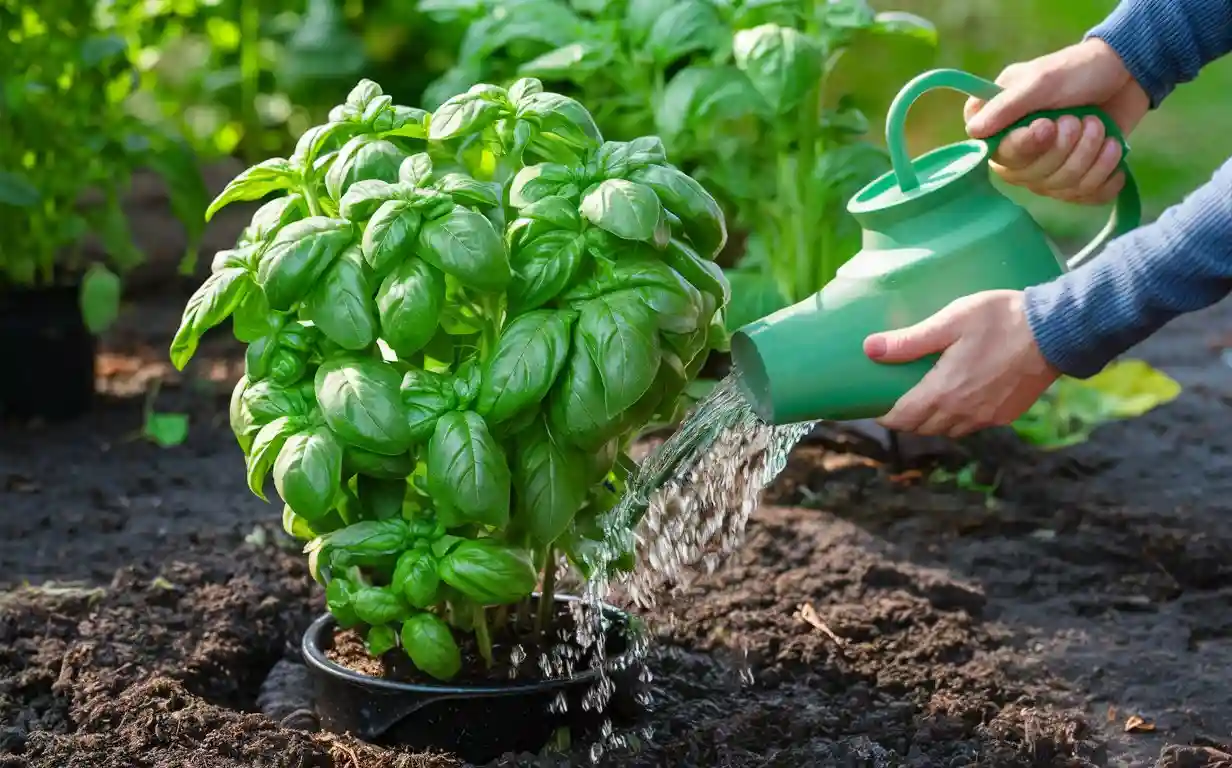
Basil Care in Hot Weather
Basil thrives in warm temperatures, but extreme heat can stress the plant and affect its growth and yield. Here are some essential care tips for basil plants in hot weather:
- Provide shade: Protect basil plants from the scorching midday sun by providing partial shade. You can use shade cloths, and umbrellas, or plant taller companion plants nearby to create shade.
- Water regularly: Water basil plants deeply and regularly, especially during hot, dry weather. Avoid overwatering, as soggy soil can lead to root rot.
- Fertilize sparingly: Fertilize basil plants lightly during hot weather. Excessive fertilization can burn the roots and stress the plant.
- Mulch around the plants: Mulching around basil plants helps retain moisture, regulate soil temperature, and suppress weeds. Use organic materials like straw, compost, or shredded leaves as mulch.
- Prune regularly: Prune basil plants regularly to encourage bushier growth and prevent the plant from becoming leggy. Pruning also helps improve air circulation and reduce the risk of disease.
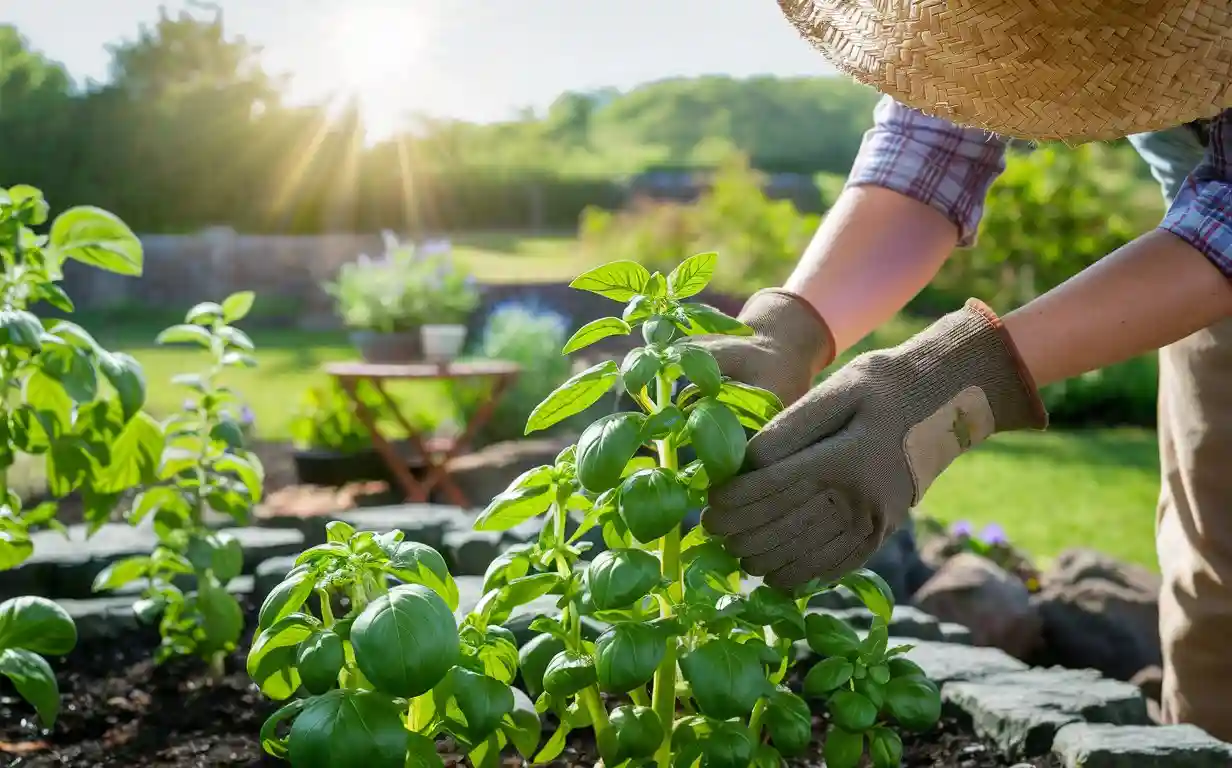
Watering Basil in Hot Weather
Basil plants require regular watering, especially during hot weather. The frequency of watering will depend on factors such as the temperature, humidity, and soil conditions. Here are some guidelines for watering basil in hot weather:
- Water deeply and regularly: Water basil plants deeply and allow the soil to dry out slightly between waterings. Avoid overwatering, as this can lead to root rot.
- Water in the morning: Water basil plants in the morning so that the leaves have time to dry out before nightfall. This helps prevent fungal diseases.
- Use mulch: Mulching around basil plants helps retain moisture and regulate soil temperature.
- Check the soil moisture: Before watering, check the soil moisture by inserting your finger into the soil. If the soil is dry up to the first knuckle, it’s time to water.
- Water at the base of the plant: Avoid watering the leaves of basil plants, as this can promote disease. Water at the base of the plant directs the water toward the roots.
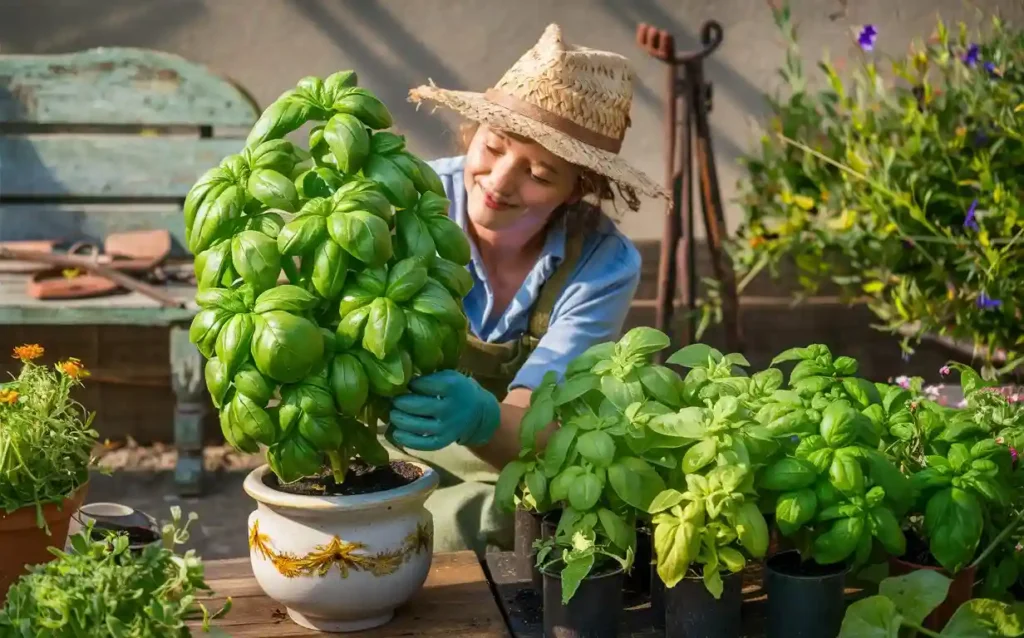
Fertilizing Basil in Hot Weather
Fertilizing basil during hot weather requires a delicate balance. While basil benefits from regular feeding, excessive fertilization can stress plants and exacerbate heat problems.
Choose a balanced fertilizer with equal parts nitrogen, phosphorus, and potassium. Apply it at half strength during hot weather, and only when the soil is moist. Avoid fertilizing during the hottest part of the day, as this can burn the roots.
Organic fertilizers, such as compost or manure, provide a slow-release source of nutrients that is less likely to cause fertilizer burn. If using organic fertilizers, apply them sparingly and work them into the soil around the plants.
Monitor basil plants closely for signs of nutrient deficiency or excess. Yellowing leaves may indicate nitrogen deficiency, while brown or crispy leaves may indicate fertilizer burn. Adjust the fertilization schedule accordingly.
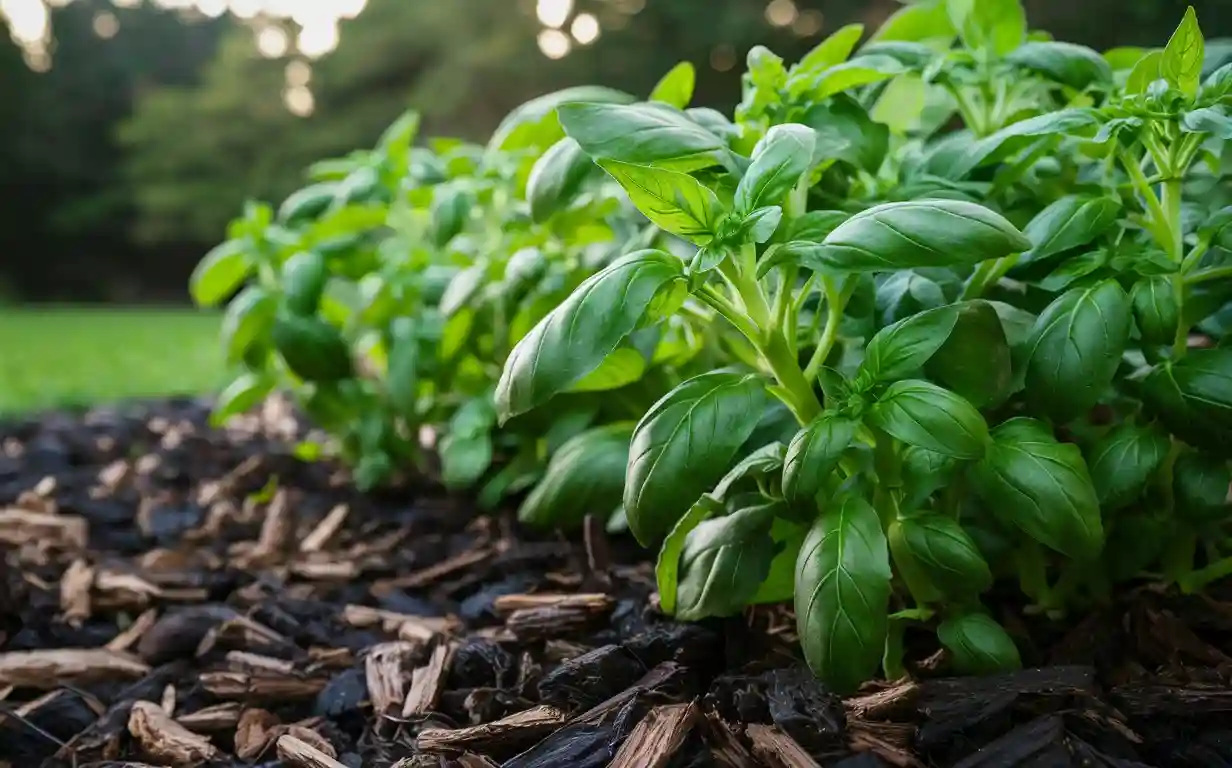
Mulching Basil in Hot Weather
Mulching around basil plants is crucial during hot weather. A layer of organic matter, such as straw, shredded leaves, or compost, helps retain soil moisture, regulate soil temperature, and suppress weeds. Mulch acts as an insulator, preventing the soil from heating up excessively and protecting the roots from heat stress. It also helps reduce evaporation, ensuring that the soil remains moist for longer periods.
When mulching basil, spread a 2-3 inch layer around the base of the plants, keeping it away from the stems to prevent rot. Water the mulch thoroughly after application to help it settle and retain moisture. As the mulch decomposes, it adds nutrients to the soil, further benefiting the basil plants.
Mulching is a simple yet effective way to protect basil plants from heat stress and ensure their optimal growth and productivity during hot weather.
Pruning Basil in Hot Weather
Pruning basil in hot weather helps maintain plant health and encourage new growth. Here’s how to prune basil in extreme heat:
- Remove dead or damaged leaves: Remove any yellowed, wilted, or brown leaves to prevent disease and promote airflow.
- Prune overgrown stems: Trim back any stems that have become too long or leggy. This encourages bushier growth and prevents the plant from becoming top-heavy.
- Pinch back tips: Gently pinch back the tips of new growth to encourage lateral branching. This results in a fuller, more compact plant.
- Avoid excessive pruning: Do not remove more than one-third of the plant’s growth at a time. Over-pruning can stress the plant and reduce its ability to withstand heat.
- Prune during cooler hours: Prune basil in the morning or evening when temperatures are cooler. This minimizes stress on the plant.
Regular pruning promotes healthy growth, prevents disease, and ensures a continuous supply of fresh basil throughout the hot summer months.
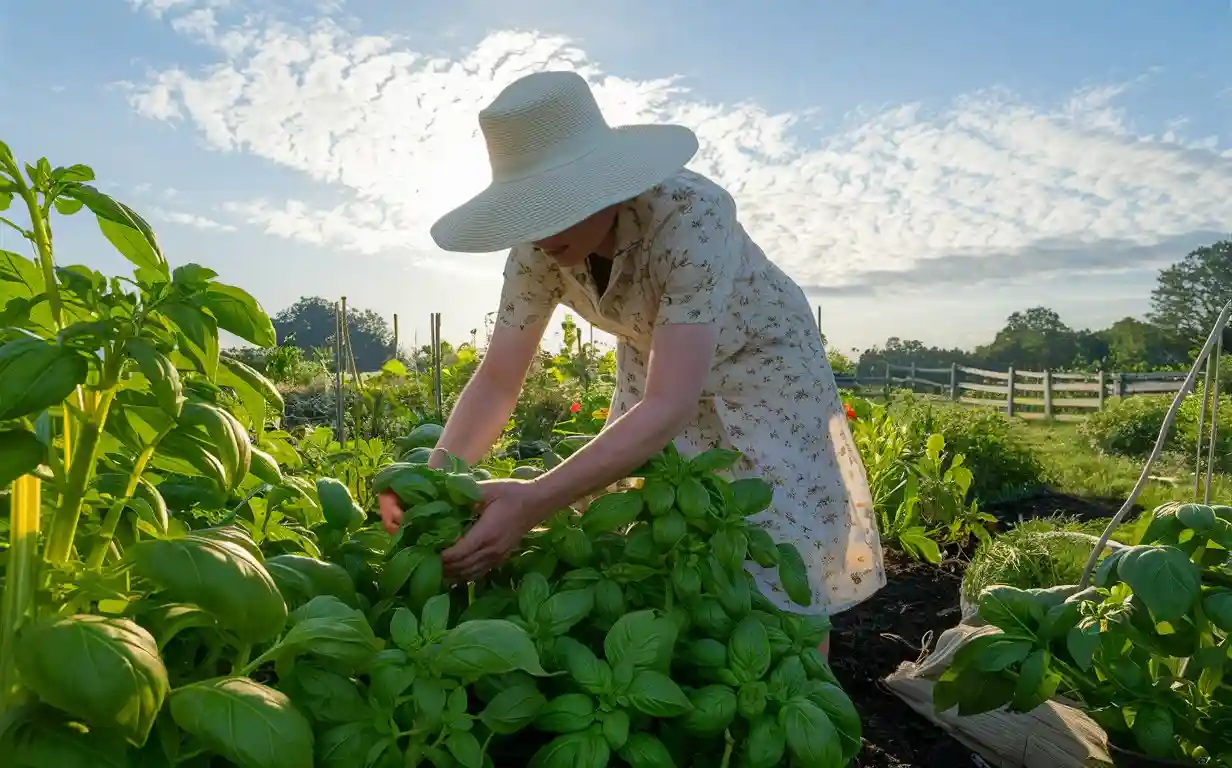
Harvesting Basil in Hot Weather
Harvesting basil in hot weather requires extra care to prevent wilting or heat damage. Here are some tips for harvesting basil in hot climates:
- Harvest early in the morning: The coolest time of day is ideal for harvesting basil. This helps prevent wilting and reduces the risk of heat stress.
Cut stems near the base: Use sharp, clean shears to cut basil stems about 1/4 inch above a leaf node. This encourages new growth and maintains the plant’s shape.
Remove flowers: If basil plants start to flower, remove the flower spikes promptly. Flowering can divert energy from leaf production and reduce the overall yield.
Handle gently: Avoid bruising or damaging basil leaves during harvesting. Handle them gently and place them in a cool, shaded area immediately.
Store properly: Store harvested basil in a refrigerator or cool, dark place. Wrap the basil loosely in a damp paper towel or plastic bag to maintain freshness.
Troubleshooting Basil’s Problems in Hot Weather
Basil plants may encounter various problems during hot weather, such as wilting, yellowing leaves, or stunted growth. Here are some common issues and their potential solutions:
Wilting: Wilting is a sign of water stress. Ensure that your basil plants are receiving adequate water, especially during hot and dry weather. Water deeply and regularly, allowing the soil to dry out slightly between waterings.
Yellowing leaves: Yellowing leaves can indicate nutrient deficiencies, particularly nitrogen deficiency. Fertilize your basil plants with a balanced fertilizer to provide essential nutrients. Avoid over-fertilizing, as this can burn the roots.
Stunted growth: Stunted growth can be caused by excessive heat or lack of nutrients. Ensure that your basil plants are receiving adequate sunlight, water, and nutrients. Consider providing shade during the hottest part of the day to prevent heat stress.
Pests and diseases: Heat stress can weaken basil plants, making them more susceptible to pests and diseases. Regularly inspect your plants for signs of infestation or infection. Treat any problems promptly using appropriate pest control or fungicidal measures.
By addressing these common problems, you can help your basil plants thrive even in hot weather conditions.
Frequently Asked Questions
1. Can basil survive in hot weather?
Yes, basil is a heat-tolerant herb that can withstand temperatures up to 35°C (95°F). However, prolonged exposure to extreme heat can cause stress and damage to the plant.
2. What temperature range is best for basil?
Basil thrives within a temperature range of 65°F (18°C) to 85°F (29°C). Temperatures below 50°F (10°C) or above 95°F (35°C) can be harmful to basil plants.
3. How can I protect basil from heat stress?
To protect basil from heat stress, provide partial shade, water regularly, fertilize sparingly, mulch around the plants, and prune regularly.
4. How often should I water basil in hot weather?
Water basil deeply and regularly, especially during hot, dry weather. Allow the soil to dry out slightly between waterings to prevent overwatering.
5. Can I fertilize basil in hot weather?
Yes, but fertilize sparingly during hot weather. Excessive fertilization can stress the plant. Use a balanced fertilizer at half-strength.